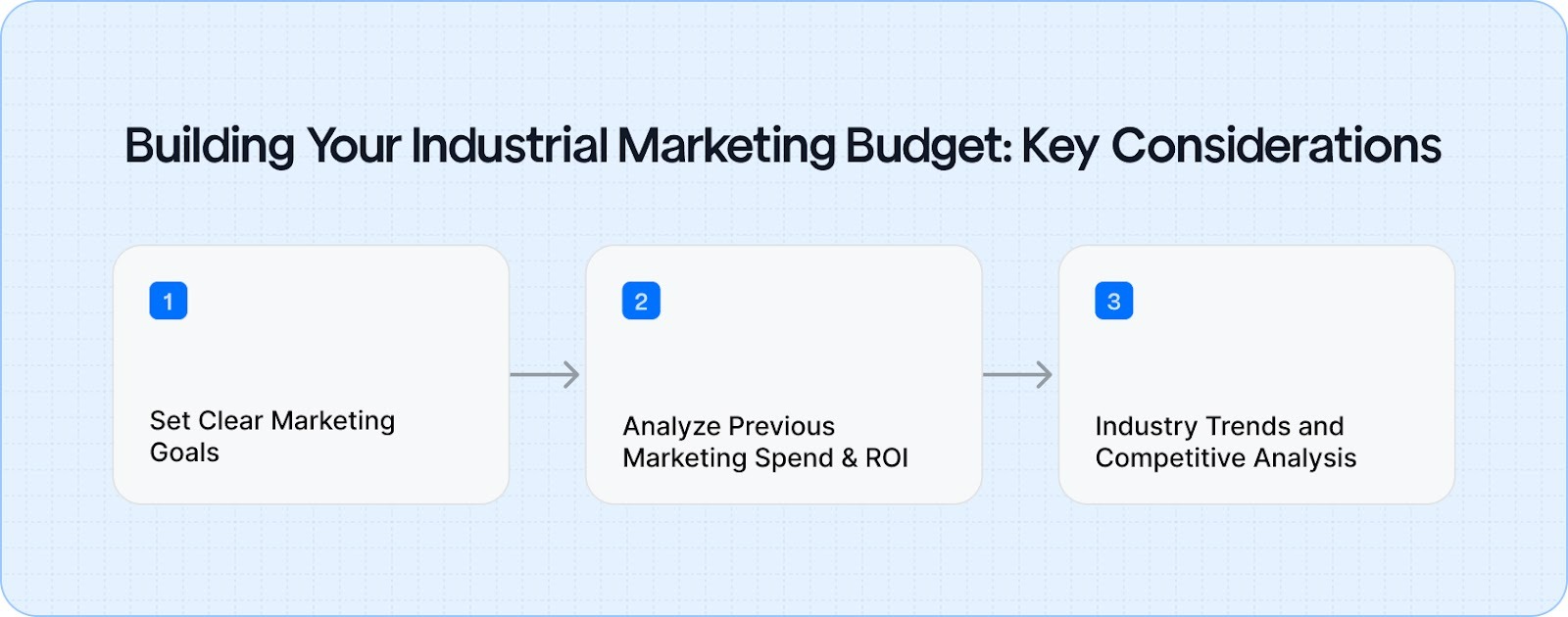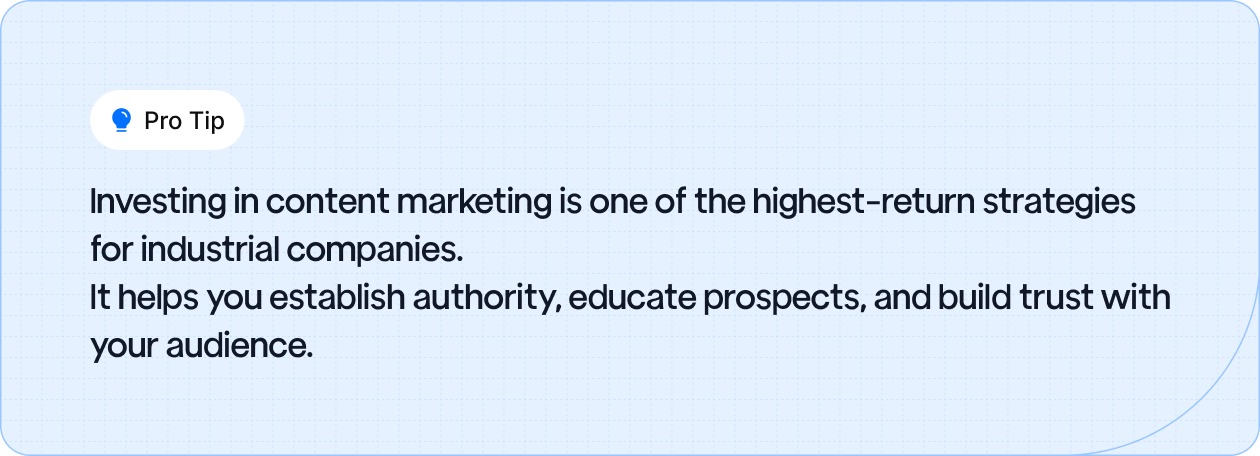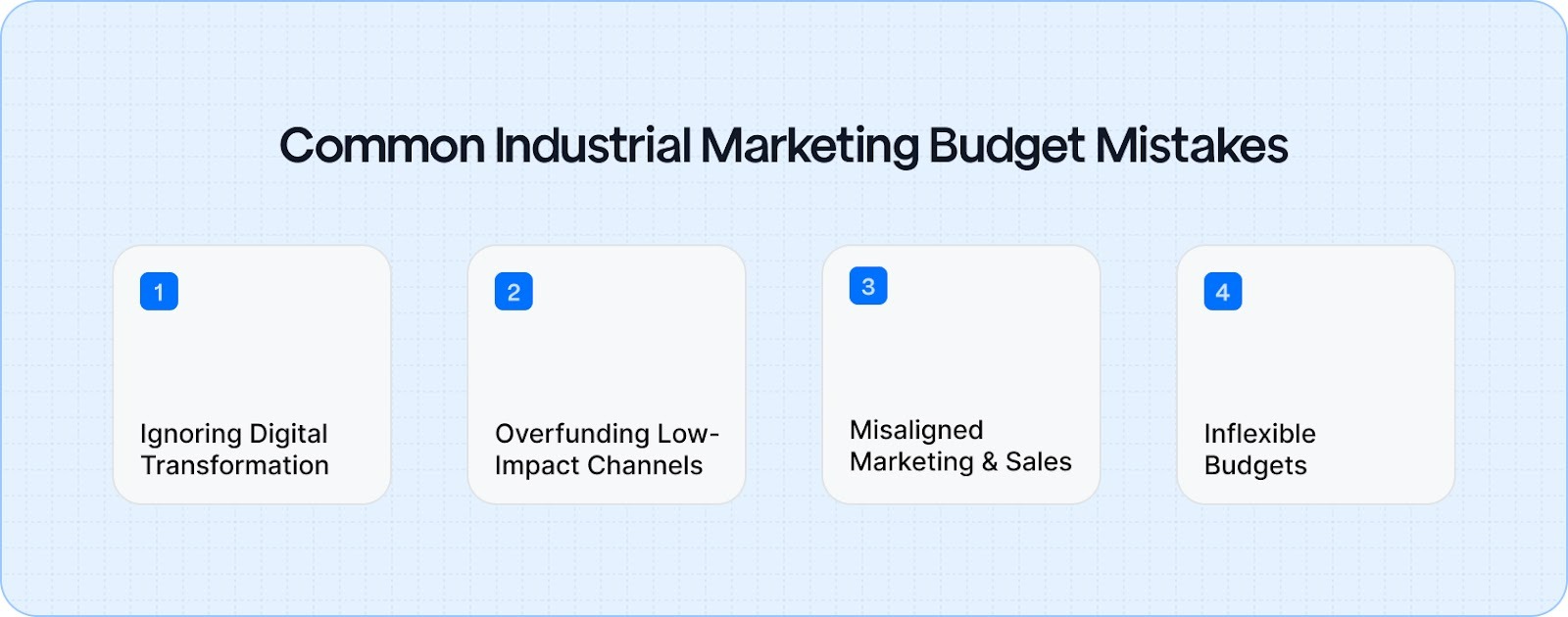You’ve probably faced this before: your marketing budget is shrinking, but the pressure to deliver results is growing.
As an industrial business, convincing leadership to allocate more funds for marketing can feel like an uphill battle. The challenge is aligning marketing efforts with a sales cycle that’s often slow, complicated, and reliant on long-term relationships.

Traditional marketing budgets simply don’t cut it anymore, and you're left wondering: How do you balance the need for marketing investment with the reality of limited resources?
This guide will show you how to craft a marketing budget that speaks the language of your CFO, maximizes ROI, and aligns with the unique sales challenges of your industry.
Understanding the Role of Marketing in Industrial Businesses
Marketing in industrial businesses is no longer a secondary function. It’s a critical driver that helps companies remain competitive in a fast-evolving marketplace, particularly as buyers become more independent and informed.
Why Marketing Is Essential for Industrial Companies?
Marketing helps industrial companies stand out in an increasingly crowded market. Today’s buyers are researching solutions online before engaging with sales teams, making marketing a vital part of the customer journey.
Historical Underestimation of Marketing in the Industrial Sector
For years, industrial companies viewed marketing as supplementary to sales, focusing on trade shows and direct sales.
This limited the potential to engage digitally-savvy buyers who prefer to make decisions based on online information.
Reframing Marketing as an Investment, Not an Expense
Successful industrial businesses are shifting their mindset, treating marketing as a strategic investment that directly drives customer acquisition and revenue.
By reallocating resources toward digital and content-focused strategies, businesses are seeing measurable improvements in lead generation.
How Much Should You Spend on Marketing?
Determining the right budget for industrial marketing requires balancing historical data, business size, and market shifts. Understanding industry benchmarks and allocating spend based on your specific needs is key to maximizing ROI.
- Industry Benchmark: Most industrial businesses allocate 5-7% of their revenue toward marketing. However, depending on company size and market focus, this figure can vary significantly.
- Why Marketing Budgets Vary by Business Size and Type: Small businesses may focus their budgets on high-impact, cost-effective digital strategies, while larger companies can afford broad-based campaigns that reach a wider audience.
- Factors That Impact Marketing Budget Allocation:
- Business Size
- Sales Cycle Length
- Competition
- Market Trends and Shifts (e.g., post-pandemic adjustments)
Pro Tip: Track and adjust your marketing budget to reflect industry shifts and competitor actions, ensuring you remain competitive and relevant.
Building Your Industrial Marketing Budget: Key Considerations

A successful marketing budget starts with clear goals and insights from past campaigns. By understanding where your money went and how it worked, you can better allocate funds for future success.
- Step 1: Set Clear Marketing Goals
Define both short-term and long-term objectives. These could range from brand awareness to lead generation and customer retention, all of which require targeted budget allocation.
- Step 2: Analyze Previous Marketing Spend and ROI
Review past marketing activities and identify which initiatives provided the highest return. This data-driven approach helps optimize future budgets.
- Step 3: Industry Trends and Competitive Analysis
Monitor your competitors' marketing spend and strategies. Adjust your budget allocation accordingly to ensure you're investing in the right channels to stay ahead.
Must Read: Craft a Winning Sales & Marketing Budget for Manufacturers
The Ideal Breakdown of Your Marketing Budget
An effective marketing budget needs a balance between digital marketing, traditional methods, and customer retention. Prioritizing these elements based on their impact will help you achieve maximum ROI.
- Digital Marketing (53.2% of Manufacturing Marketing Spend Post-COVID):
- SEO (Search Engine Optimization)
- Content Marketing (Blogs, Case Studies, Whitepapers)
- Paid Advertising (Google Ads, LinkedIn, PPC)
- Social Media Marketing
- Email Marketing & Automation Tools
- Traditional Marketing:
- Trade Shows and Events
- Print Media & Direct Mail
- Customer Experience and Retention:
- CRM Tools
- Customer Support and Post-Sales Engagement
Market Research: Continuous market research ensures your strategy is data-driven and adaptive.

Marketing Budgeting by Objectives: Two Effective Approaches
Budgeting by objectives ensures your marketing spend directly aligns with measurable business goals. Using a percentage of sales or specific objectives keeps your spending focused and results-driven.
Approach 1: Marketing Budget by Percentage of Sales
This method ties marketing spend directly to revenue, typically allocating 5-7% of gross sales. It’s simple and effective, but may not be adaptable enough for industries with fluctuating needs.
Approach 2: Marketing Budget by Specific Objectives
Allocate budget based on specific, measurable goals like increasing marketing qualified leads (MQLs) by 20% or improving conversion rates by 10%. This is a more flexible, outcome-oriented approach.
- Pros: Directly tied to business goals.
- Cons: Requires precise forecasting and a clear understanding of sales cycles.
Also Read: 25+ Proven Strategies to Transform Your Industrial Content Marketing
Common Mistakes to Avoid When Setting an Industrial Marketing Budget

Budgeting mistakes can lead to wasted resources and missed opportunities. By focusing on ROI-driven activities, you can avoid common pitfalls and ensure your marketing budget is working for you.
- Ignoring Digital Transformation: Traditional methods like trade shows are important, but focusing exclusively on them while neglecting SEO, social media, and digital advertising limits your reach and growth.
- Overfunding Underperforming Channels: Avoid wasting money on vanity metrics like impressions. Focus on channels that deliver real, measurable results.
- Failing to Align Marketing and Sales Goals: Marketing and sales need to work together towards shared goals. Without clear alignment, marketing efforts can fall flat.
- Lack of Flexibility: Marketing budgets should be dynamic and able to adjust based on performance metrics and changing business needs.
Pro Tip: Regularly review and adjust your budget to keep it aligned with evolving business goals. Continuous monitoring ensures you remain flexible and responsive to market changes.
How to Track the ROI of Your Marketing Spend
Tracking ROI helps ensure your marketing spend is effective and aligned with business goals. By setting clear KPIs and using the right tools, you can optimize your marketing efforts.
Setting Measurable KPIs
Track key metrics that directly impact business growth:
- Organic Traffic: Indicates the effectiveness of SEO.
- Lead Generation: Measures how well you’re attracting prospects.
- Conversion Rates: Shows how well your efforts turn leads into customers.
- Sales-Qualified Leads (SQLs): Helps measure how many leads are ready for sales.
Using Tools to Measure Success
Leverage tools to track performance:
- Google Analytics: Tracks website traffic and conversions.
- CRM Reports: Monitors lead behavior and sales opportunities.
- Marketing Automation Platforms: Measures campaign success and engagement.
Adjusting Based on Insights
Optimize continuously by:
- Reviewing performance and reallocating budget to high-performing areas.
- Using data to pivot strategies when necessary for better results.
Take Control of Your Marketing Budget: Drive Results and Achieve Long-Term Growth
A well-planned marketing budget is a powerful investment in your company’s future. By aligning your marketing spend with clear business goals, you can ensure that every dollar contributes to measurable growth and long-term success.
However, blindly following a generic approach won’t get you the results you need.
FAQs
Q1. What percentage of revenue should industrial companies allocate to marketing?
A1. Most industrial companies allocate between 5–7% of their annual revenue to marketing. However, this can vary based on company size, growth stage, and strategic goals.
Q2. How do I determine the right marketing budget for my manufacturing business?
A2. Start by defining clear business objectives, such as increasing brand awareness or generating leads. Then, align your budget to support these goals, considering factors like sales cycle length and competition.
Q3. What are the key components of an industrial marketing budget?
A3. An effective industrial marketing budget typically includes:
- Digital marketing (SEO, content, PPC, social media)
- Traditional marketing (trade shows, print media)
- Customer experience and retention (CRM tools, support)
- Market research and analytics
Q4. How can I track the ROI of my marketing spend?
A4. Utilize tools like Google Analytics, CRM systems, and marketing automation platforms to monitor KPIs such as organic traffic, lead generation, conversion rates, and sales-qualified leads (SQLs).
Q5. What common mistakes should I avoid when setting an industrial marketing budget?
A5. Avoid:
- Neglecting digital transformation by overemphasizing traditional methods
- Overfunding underperforming channels
- Failing to align marketing and sales goals
- Lacking the flexibility to adjust the budget based on real-time performance data
Q6. How does business size impact marketing budget allocation?
A6. Larger businesses often have more resources to allocate a higher percentage of revenue to marketing, enabling broader strategies. Smaller companies may need to be more strategic, focusing on cost-effective tactics like targeted digital campaigns and SEO.
Q7. What role does content marketing play in the industrial sector?
A7. Content marketing is crucial for establishing authority and educating the audience. Investing in high-quality content can lead to higher engagement and better ROI in the industrial sector.




















.webp)








.webp)



.svg)







.svg)